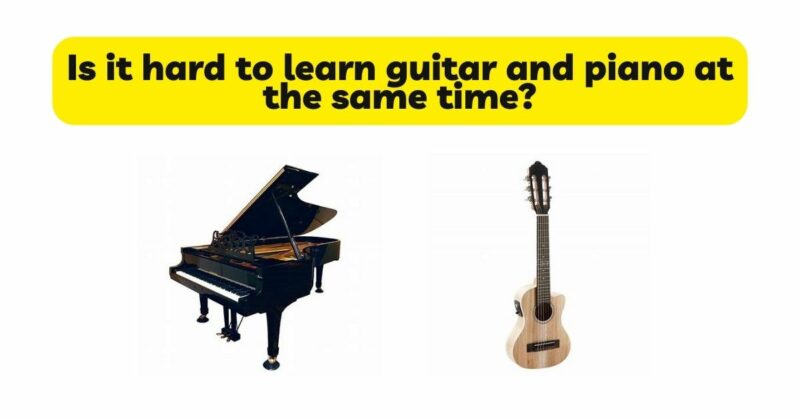Embarking on the journey of learning a musical instrument requires dedication, patience, and a willingness to overcome challenges. For some, the desire to simultaneously learn both the guitar and piano may arise, driven by the allure of mastering two versatile instruments. However, this dual pursuit comes with its own set of difficulties. In this article, we will delve into the challenges faced when learning guitar and piano simultaneously. By examining factors such as technique, coordination, time commitment, and cognitive load, we can gain insights into the level of difficulty associated with this endeavor.
- Technical Demands: Mastering the guitar and piano individually requires a significant investment of time and effort. Learning both instruments simultaneously increases the complexity of the task. Each instrument possesses unique technical demands that require focused practice and attention. The guitar requires finger dexterity, coordination between strumming and fretting, and mastering chord shapes and picking patterns. The piano demands hand independence, precise finger movements, and the ability to navigate the keyboard confidently. Balancing the technical demands of both instruments simultaneously can be challenging.
- Hand Coordination and Independence: Learning guitar and piano concurrently necessitates the development of exceptional hand coordination and independence. Each hand must perform distinct tasks on separate instruments. The guitar hand executes chord shapes, picking or strumming patterns, while the piano hand plays melodies, chords, or accompaniment. Coordinating these movements and developing hand independence requires diligent practice and focused attention. Some individuals may find it challenging to synchronize the movements of both hands effectively, especially in the early stages of learning.
- Time Commitment and Practice: Learning a single instrument requires consistent practice and time commitment. Learning two instruments simultaneously demands an even greater investment of time and effort. Balancing practice sessions for both instruments can be daunting, as each instrument requires dedicated practice to make progress. Time management and setting realistic practice goals become crucial factors in maintaining progress on both instruments. Commitment to regular practice schedules and effective time management strategies is essential for successfully learning guitar and piano simultaneously.
- Cognitive Load and Mental Processing: Simultaneously learning guitar and piano requires managing a significant cognitive load. Each instrument demands attention to technique, hand movements, rhythm, timing, and musical interpretation. Splitting attention between both instruments can increase the mental processing load, potentially leading to slower progress and frustration. Cognitive load management strategies such as breaking down complex tasks into smaller components, focused practice on specific skills, and regular review can help mitigate the challenges associated with the simultaneous learning process.
- Music Theory and Instrument Specificities: Both guitar and piano involve music theory concepts, albeit in different ways. Learning and understanding music theory for each instrument concurrently can be overwhelming for beginners. The guitar relies heavily on chord-based playing, whereas the piano involves a more linear representation of musical concepts. Grasping theory-specificities for both instruments simultaneously requires focused study and consolidation of knowledge. Investing time in understanding the theory behind each instrument can enhance musical understanding and facilitate the simultaneous learning process.
- Instrument-Specific Techniques: Each instrument has its own unique set of techniques and playing styles. Learning guitar and piano concurrently means navigating the techniques of both instruments simultaneously. Acquiring fingerpicking techniques, strumming patterns, chord transitions, and fretboard navigation on the guitar while simultaneously developing piano technique and keyboard navigation can be mentally and physically demanding. Breaking down technique practice into manageable components, utilizing effective practice routines, and seeking guidance from experienced teachers can help address the challenges associated with acquiring instrument-specific techniques.
- Personal Goals and Expectations: Personal goals and expectations play a significant role in evaluating the difficulty of learning guitar and piano simultaneously. Each individual’s musical aspirations, time availability, and commitment levels vary. While some may find it challenging to balance the demands of learning both instruments, others may thrive on the simultaneous pursuit, finding it rewarding and stimulating. Setting realistic goals, adjusting expectations, and maintaining a positive mindset are crucial factors in overcoming the difficulties associated with learning guitar and piano concurrently.
Conclusion: Learning guitar and piano simultaneously presents a significant challenge, as it requires mastery of two distinct instruments with their unique technical demands, hand coordination requirements, time commitments, and cognitive load. While the simultaneous pursuit may be challenging, it is not insurmountable with proper planning, effective practice strategies, and dedication. The level of difficulty varies among individuals based on personal goals, prior musical experience, and commitment levels. Those embarking on the journey of learning guitar and piano simultaneously should embrace patience, perseverance, and a growth mindset. Seek guidance from experienced teachers, utilize effective practice strategies, and manage time effectively. By doing so, the dual challenge of learning guitar and piano simultaneously can be transformed into a rewarding and enriching musical journey, unlocking new creative possibilities and expanding musical horizons.


